Can John Sharp protect his maroon empire?
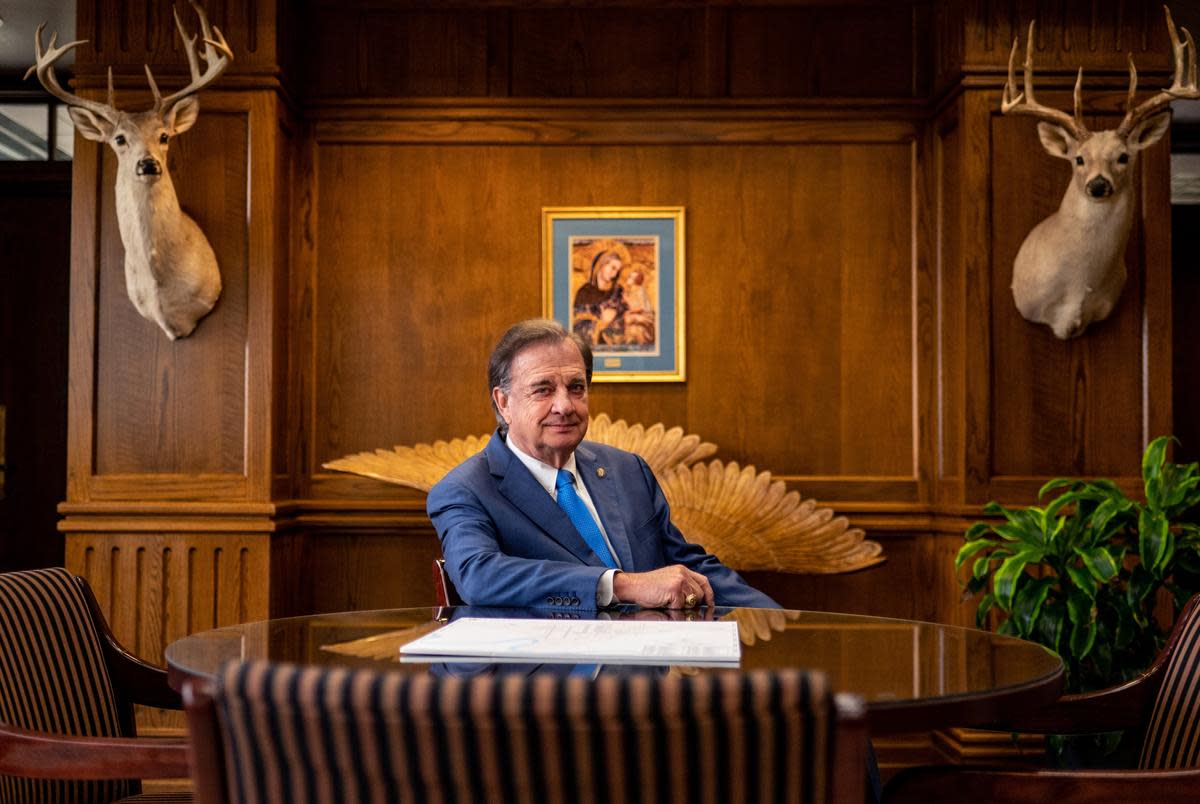
Editor's note: This story contains explicit language.
A few months into the COVID-19 pandemic, John Sharp received a call from someone identifying himself as Ben Carson, then the U.S. secretary of housing and urban development. The caller said he wanted the Texas A&M System chancellor to help set up a trial testing whether a compound from the oleander plant could help combat the new virus.
Sharp didn’t buy it. He figured it was a prank call from Rick Perry, the former Texas governor and then U.S. secretary of energy who was Sharp’s college dormmate and friend before becoming a political rival.
“I said, ‘Yea, Perry. You’re full of shit,’” Sharp recounted in an interview with The Texas Tribune as he drove his black pickup truck on a warm day around College Station last year.
But it wasn’t a prank call. Carson was on the other end of the line. Sharp quickly realized his mistake.
“I’m so sorry, Mr. Secretary,” Sharp recalled telling the Trump Cabinet member, with a laugh. “I thought this was Rick Perry screwing with me.”
Then he got down to business.
The evidence was questionable, and the oleander compound wasn’t known to be safe to test on humans to fight the virus. But Carson was convinced. And that put Sharp in a no-win situation: Risk disappointing the head of a federal agency or grant the request and infuriate his faculty by greenlighting a scientifically dubious experiment as a political favor.
Sharp took another route. He quickly used his political connections and donated funds to quietly allocate $50,000 for a private doctor to set up a trial.
Ultimately, The Dallas Morning News uncovered the story and the Food and Drug Administration sent the doctor a warning letter for giving people an experimental drug without their permission. But Sharp and Texas A&M emerged relatively unscathed.
It's this kind of political maneuvering and eagerness to please that has allowed Sharp, a former state comptroller and a veteran of both houses of the Legislature, to become the longest-serving chancellor in the Texas A&M University System since it was established in 1948. In his 12 years atop the system, which now has a $7.8 billion budget, he has overseen a massive expansion and successfully straddled the chasm between the demands of university faculty and students and conservative state leaders who have increasingly different ideas of how public universities should operate.
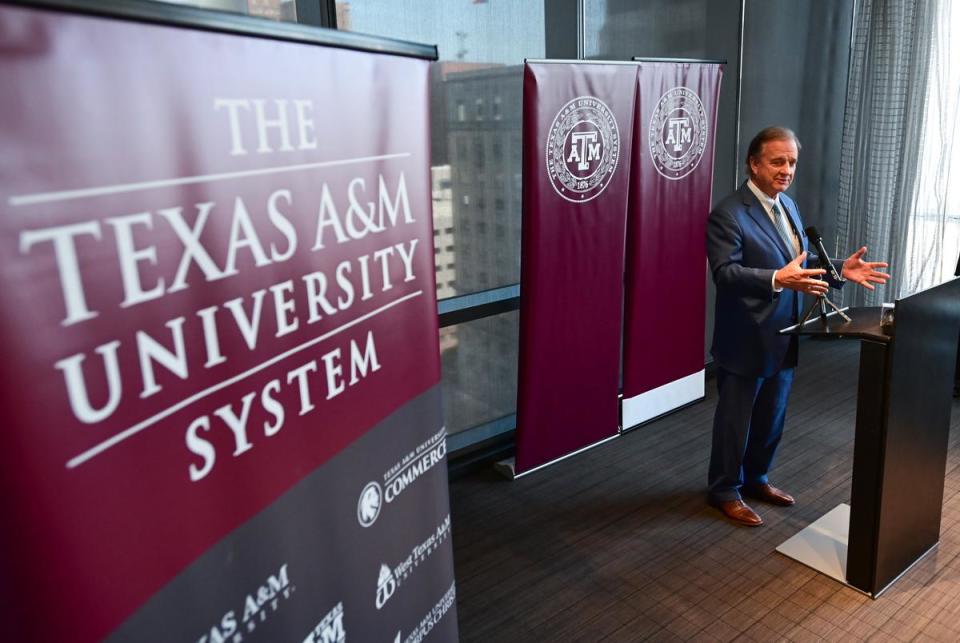
He's a master at getting more money from the Legislature. Research spending at the flagship campus at College Station now tops $1 billion, the first in Texas to reach that mark. He acquired a law school, launched new degree programs, and expanded the system’s presence in Fort Worth and Houston. This summer, the system announced it was going into space.
Stand next to Sharp for long enough and he’ll rattle off a list of A&M’s accomplishments: the law school is ranked in the top 30 in the country by U.S. News and World Report. The Wall Street Journal recently ranked the flagship the best university in Texas. Have you caught the latest episode of his weekly interview television show, ‘Around Texas?’
But lately Sharp’s style of political maneuvering hasn't kept him and the system out of the type of conflicts that are embroiling public universities in Republican-dominated states.
His protégée, former Texas A&M University President Kathy Banks, was forced to resign in July after the Tribune reported that A&M had watered down a job offer to a Black journalism professor whom the university had recruited to revive its journalism program after conservative board members raised concerns with her credentials. The professor, Kathleen McElroy, decided to stay at the University of Texas, settling with Texas A&M for $1 million.
Days later, Sharp came under fire when the Tribune revealed that he was involved in the swift suspension with pay of a pharmacology professor, Joy Alonzo, who was accused by a politically connected student of criticizing Lt. Gov. Dan Patrick during a lecture. Text messages show Sharp updated Patrick within hours of the complaint that the professor was placed on leave “pending investigation re firing her.”
Both cases stirred outrage and accusations of political interference at A&M. More broadly, they raised questions about how anyone atop a major Texas public university — even someone as politically astute as Sharp — can navigate the competing forces pulling at higher education in such a conservative state.
And maybe more importantly — can all that money, growth, and the political wins be considered a success if some on campus say the flagship still doesn't feel like a place that welcomes everyone to the table?
A handful of crickets
Sharp, 73, blames his stunted political career on an impulsive decision to eat a bunch of crickets.
He recounted the story on a flight to Austin on the system's private jet last year. Over the din of the maroon and white plane's motor, Sharp said he was with Perry and some other college friends on a search for tiny cans of Schlitz beer to liven up a weekend trip, when Perry flashed a middle finger to passing motorcyclists.
The men, whose jackets bore the name of the Bandidos motorcycle gang, parked their bikes and walked toward them, Sharp recounted. He knew they were not to be messed with, especially by a group of drunk college students.
“Perry’s behind me squealing like a pig stuck under a gate,” Sharp recalled. He shouted, “Do something! Do something!”
It was cricket season. So, as Sharp tells the story, he grabbed two handfuls of the insects off the ground and stuffed them in his mouth.
“The cricket juice is running down my face and these guys looked at me and said, ‘Oh you’re too f-ing drunk. Let’s leave,’” Sharp said, admitting he was just as scared as Perry.
Sharp’s college career at Texas A&M, from which he graduated in 1972, was rowdy but productive. He attended an A&M in transition from an all-male, racially segregated school that had just accepted its first Black student six years prior to his arrival. He served as student body president, and was part of the Corps of Cadets, a tradition-bound ROTC-like program.
After college, Sharp followed well-worn grooves into Texas politics, landing a job at the Legislative Budget Board. In 1978, he was elected to the Texas House as a 28-year-old representing his native Victoria County, in southeast Texas. Four years later, the conservative Democrat was elected to the Texas Senate.
In 1986, Sharp was elected to the Texas Railroad Commission, which oversees the state’s oil and gas industry. Then, he served two terms in the 1990s as the state comptroller.
But the political grounds shifted under him. In 1998, Sharp ran against his former classmate Perry for lieutenant governor and lost by two percentage points. It was the beginning of Republican dominance in the state. Four years later, after Perry ascended to governor, Sharp lost the same race by six percentage points to then-Land Commissioner David Dewhurst.
Sharp surmised that eating those crickets back in college was the biggest political mistake he’d ever made.
“If I didn't eat those crickets, the [motorcycle gang] would have killed Perry and I would’ve been governor of Texas,” he quipped.
But the antics might have helped him land another job. In 2011, the Perry-appointed A&M System Board of Regents parted ways with Chancellor Mike McKinney — a former Perry chief of staff.
They replaced him with Perry’s old cricket-eating dormmate.
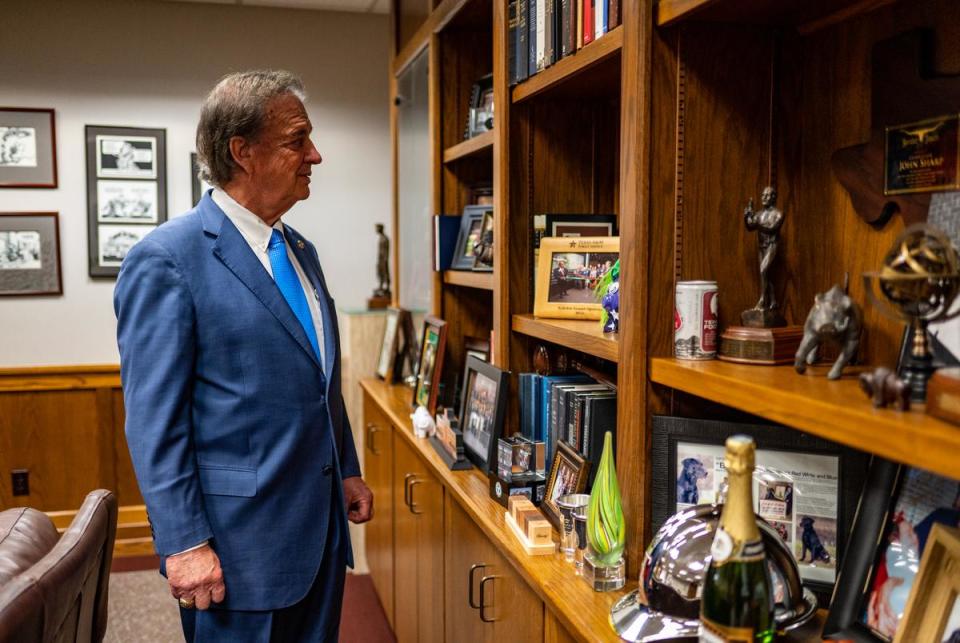
“He swings for the fences”
When Sharp became chancellor in 2011, Perry was pushing a new vision for Texas higher education concocted by a right-leaning advocacy group to overhaul tenure, create a merit-pay system for teachers and reimagine budgets for research and teaching. The A&M faculty had revolted against Sharp’s predecessor, McKinney, over some of the ideas. The president of the University of Texas at Austin at the time called the debate a fight for the soul of his university.
Momentum for the idea was fading and Sharp wasn’t particularly interested in entering that political maelstrom. He had other plans.
First, he outmaneuvered state leaders skeptical of approving new law schools in the state by acquiring Texas Wesleyan University’s law school.
Next, he initiated a nearly $500 million redesign of Kyle Field, making it the largest football stadium in the state with more than 100,000 seats (edging out rival UT-Austin by 2,614 seats).
He added “Texas A&M” to the names of multiple government agencies within the system, making clear who was saving Texans from floods, fighting wildfires and designing streets. He oversaw a vast enrollment expansion at A&M, growing it from 49,861 students in 2011 to 77,496 this fall. The system turned an empty field in Bryan, next to College Station, into a research campus known as RELLIS. There, the system is investing in hypersonics research, building a kilometer-long tunnel where researchers can test projectiles moving 10 times the speed of sound. Texas A&M edged out the University of Texas System to land a contract to manage and operate Los Alamos National Laboratory with the University of California. Last year, the federal government extended that contract for five more years.
Over the past 12 years, Sharp has added 46 faculty who are members of the National Academies — an elite group of distinguished researchers in engineering, medicine and the sciences. And helped to create one of the only programs in the country where students can earn a medical degree and master’s in engineering simultaneously.
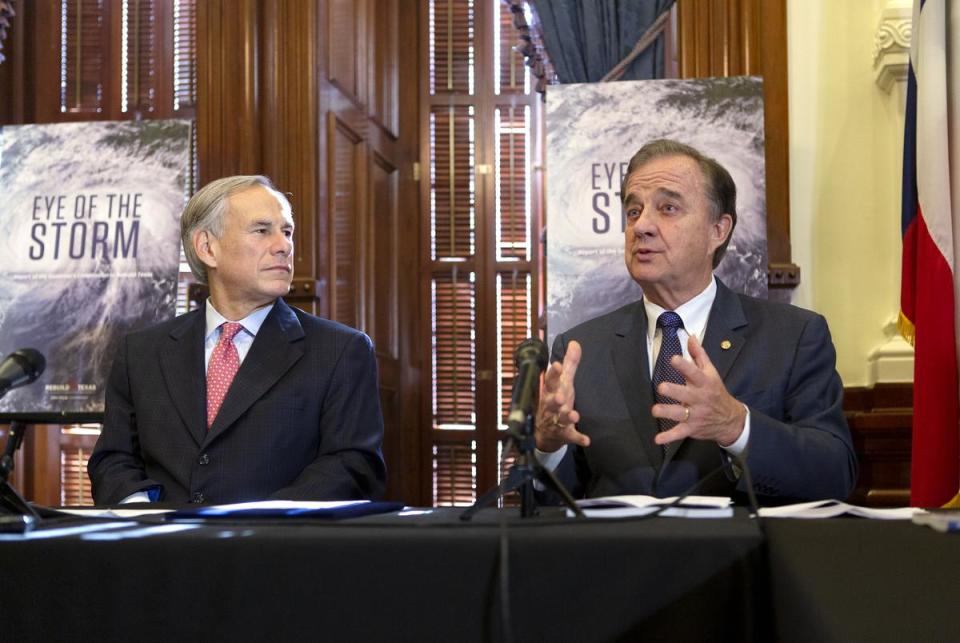
Roderic Pettigrew is one of the superstar faculty whom Sharp recruited to run that dual-degree program in Houston, known as EnMed.
Pettigrew said he was attracted to A&M not just to teach the first class of “physicianeers,” as A&M calls the EnMed students, but he liked that Sharp took risks and followed through on the idea so quickly.
“He swings for the fences,” Pettigrew said.
Still, Sharp and his maroon empire have failed to shake a long-standing criticism that A&M is not committed enough to boosting student diversity and making A&M a more welcoming place for historically excluded students.
Complaints persist about the low number of Black students enrolled at the flagship compared with Texas’ population, where Black students represent 3% of student enrollment compared to 13% of the Texas population. And students and alumni of color remain disappointed that the statue of Lawrence Sullivan Ross, a former Confederate general and president of Texas A&M who was later credited with saving the school from financial ruin, remains on campus after a renewed push in 2020 to remove or relocate it. The university’s refusal to remove the statue solidified beliefs among some students and alumni of color that only the loudest and wealthiest voices are heard.
“I don't think stakeholders like ourselves really mattered to A&M,” Erica Davis Rouse, a 1995 graduate of the university and current president of the Black Former Student Network, said. “We don't have the money. We don't have the political capital, and we don't have the numbers as far as just the sheer number of Black Aggies who have come through A&M.”
Sharp has insisted he is committed to solving these problems, but his track record suggests that he hasn’t attacked the problem as aggressively as he has other issues raised by state officials.
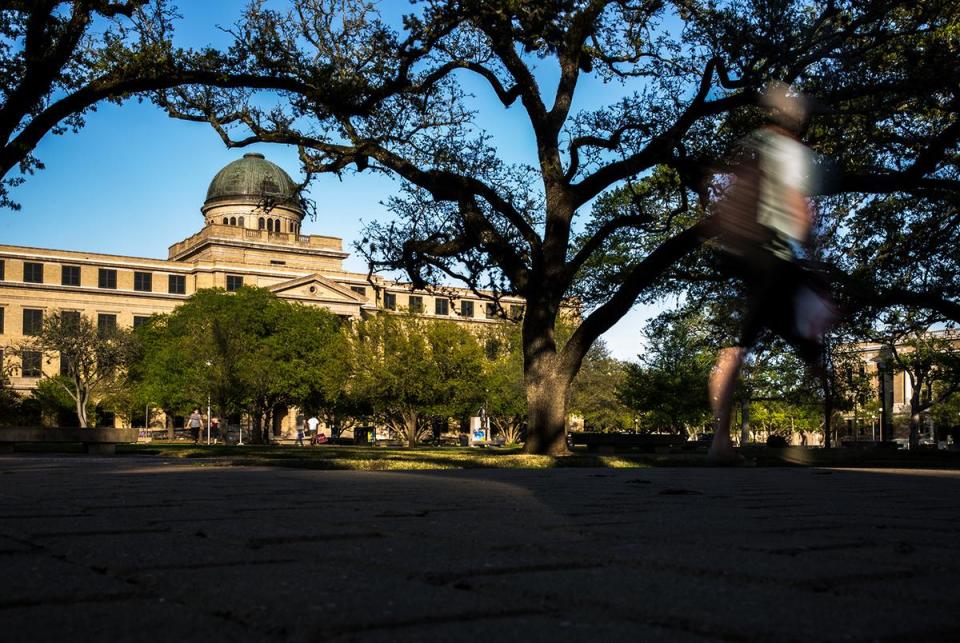
When lawmakers in 2015 wanted to allow licensed gun owners to carry guns on public university campuses, Sharp sided against his fellow higher education leaders who opposed the measure.
In a letter to the lieutenant governor, Sharp said that he wasn’t concerned about the bill’s impact on campus safety. After all, Texas A&M is steeped in military tradition.
Instead, he used the opportunity to share his main concern: money. He wrote that “properly funding the higher education of these students is the only issue that counts!”
Two years later, when Hurricane Harvey ravaged the Gulf Coast, Gov. Greg Abbott asked Sharp to lead the state’s rebuilding efforts. He took on the assignment while staying in his perch at A&M, working essentially two full-time jobs for more than a year. At the end, he produced a 177-page report with 44 recommendations to make Texas more resilient to hurricanes.
Many involved new funding for or the creation of new centers at Texas A&M.
“When he walks into the Capitol and says, ‘If you give us this money, we're gonna go build this thing for you,’ I think people go, ‘Okay, how much do you want?’” said Nim Kidd, head of the Texas Division of Emergency Management, a state agency that coordinates the state’s response to disasters. TDEM joined the Texas A&M System in 2019 after Sharp’s Hurricane Harvey efforts.
Occasionally, his ideas don’t evoke such a positive response. He had to abandon a proposal to merge two of the system’s regional universities located in Texas’ Gulf Coast after some lawmakers and community members expressed outrage. And his outspoken opposition to Texas Tech University’s pitch to open a veterinary school in Amarillo was panned as provincial and embarrassing; it was ultimately ignored.
At other times, Sharp’s colorful personality and passion for his alma mater have won him good press.
Once he returned from lunch to the A&M System office with a bunch of parakeets and tried to teach them to say the official Aggie greeting, “Howdy.” Another time, he shot off an email in the middle of the night asking for road strips to be installed on a main College Station thoroughfare so it sounds like the start of the Aggie War Hymn — “Hullabaloo, caneck, caneck” — when driven over.
He even decided to propose to his now-wife on stage at a Robert Earl Keen show christening a new campus park.
Before Keen could lead the Aggie crowd in a rendition of “The Road Goes on Forever,” Sharp got down on one knee and popped the question.
‘If not Sharp, then who?’
Sharp entered this year’s legislative session hoping his relationships would bring another windfall for his schools. The Legislature had a $32.7 billion surplus, and he wanted to send the message that universities were a great place to spend a big chunk of it.
But the culture wars kept getting in the way.
The lieutenant governor, angry over some Texas professors’ embrace of critical race theory, threatened to eliminate tenure at public universities and made banning diversity, equity and inclusion offices a legislative priority.
Christopher Rufo, a hard-right agitator based in Washington state and an architect of the national pushback against perceived left-wing indoctrination in education, had crafted legislation used across the country to dismantle DEI offices in public universities.
Throughout the legislative session, Rufo targeted various public universities in the state, including Texas Tech University, UT-Austin and Texas A&M, conducting his own public shaming tour by posting selected documents he obtained via open records requests and presenting them as evidence that school leaders were creating a “DEI bureaucracy that promotes every fashionable left-wing delusion.”
When Abbott sent a letter prohibiting state agencies and public universities from considering diversity in hiring, labeling them as political litmus tests, Sharp went a step further. Days later, he banned the use of “diversity statements” in job applications and prohibited the consideration of race in admissions, even though Texas A&M had not considered race in admissions for two decades.
“No university or agency in the A&M System will admit any student, nor hire any employee based on any factor other than merit,” Sharp said in a directive to university leaders. (This occurred a few months before the U.S. Supreme Court struck down the use of race in college admissions this summer.)
Sharp took a different approach when it came to tenure, knowing full well that eliminating the long-standing practice would decimate Texas A&M’s ability to recruit top talent. Instead, he proposed that lawmakers adopt Texas A&M’s tenure policies into state law, which he said would codify ways to grant and revoke tenure statewide into law. He also joined the state’s other chancellors in promising to keep tuition flat for the next two years — if lawmakers sent them $1 billion in new funding from the surplus.
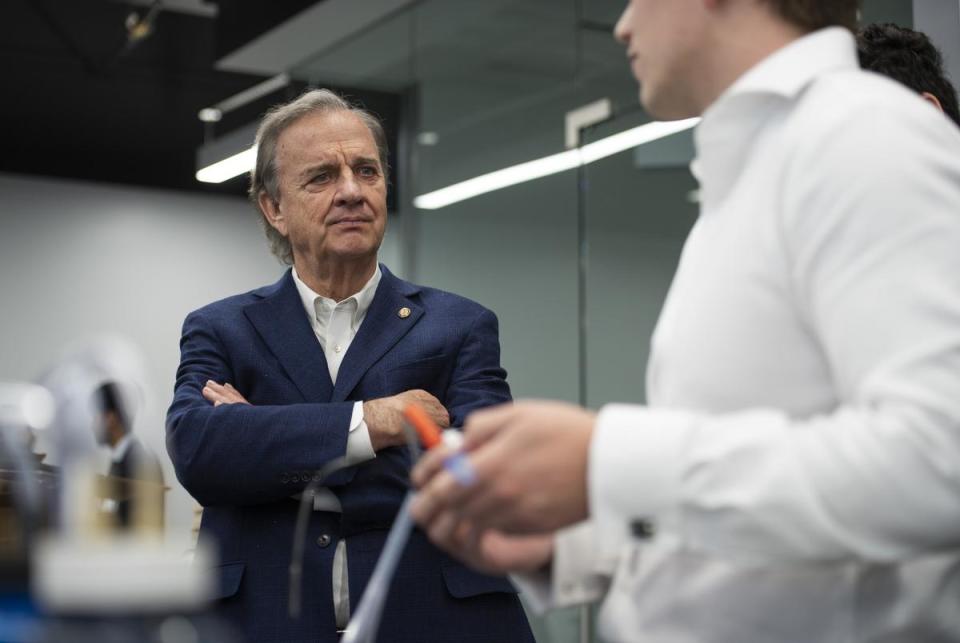
But each time Sharp tried to put out a political fire, another one flared up.
The swift suspension of Alonzo came after the lieutenant governor said he’d heard that the A&M pharmacology professor had bashed him in a lecture. The university, in the midst of pitching lawmakers why they should send the system billions in additional funding, placed her on leave within hours of Patrick’s call. Sharp told Patrick she could be fired, pending an investigation.
When the flagship campus recruited McElroy, the UT professor, who used to work at The New York Times, to run its revamped journalism school, governor-appointed regents were furious.
“We were going to start a journalism department to get high-quality conservative Aggie students into the journalism world to help direct our message,” wrote one regent in a group text message. “This won’t happen with this type of hire!”
After the Tribune uncovered both stories, an uproar commenced. Faculty rang alarms about threats to academic freedom. Department leaders questioned how they could recruit new talent. Both incidents sparked national news.
The brouhaha — especially the botched hiring of McElroy, a Black woman — renewed skepticism about Sharp's commitment or ability to protect A&M from political interference.
Students and alumni recalled Sharp’s refusal to remove the Sul Ross statue. In an interview last summer, Sharp argued that removing it would fray strong ties with the vocal Texas A&M alumni base.
“That statue was never coming down,” Sharp said. “It would have done a lot more harm and made things way unworkable with the upsetting of the former students.”
Instead, Sharp and the Board of Regents put $100 million toward student scholarships across the system and added a statue of Matthew Gaines, a Black state senator who was instrumental in pushing the state to create Texas A&M and Prairie View A&M.
Sharp said it will take more time to see the impact of that scholarship program. Preliminary data for this fall does show slight progress. Black student enrollment is at 2,643, a 10% increase over the prior year, though still hovering around 3.4% of the total student population, according to data provided by the university. Meanwhile, white students make up 50% of the total student enrollment, while Hispanic students account for nearly 23%.
Students of color say it will take more than just reaching out to make them feel their school is a welcoming place. As state leaders railed against diversity, equity and inclusion efforts on college campuses this year, they wanted Sharp to defend those initiatives the same way he defended tenure.
“There has to be some point at which you can make a stand against it,” Nicolas Le, a Texas A&M sophomore who is of Mexican and Vietnamese heritage, told the Tribune. “I know that the money does come from them, but I feel like there has to be some standards. There has to be some morals.”
But even as some professors and alumni expressed outrage, few seemed to want Sharp to leave.
“If it's not Sharp, then who would it be?” asked Rouse, the president of the Black Former Student Network. “Because we could go further backwards than we already are.”
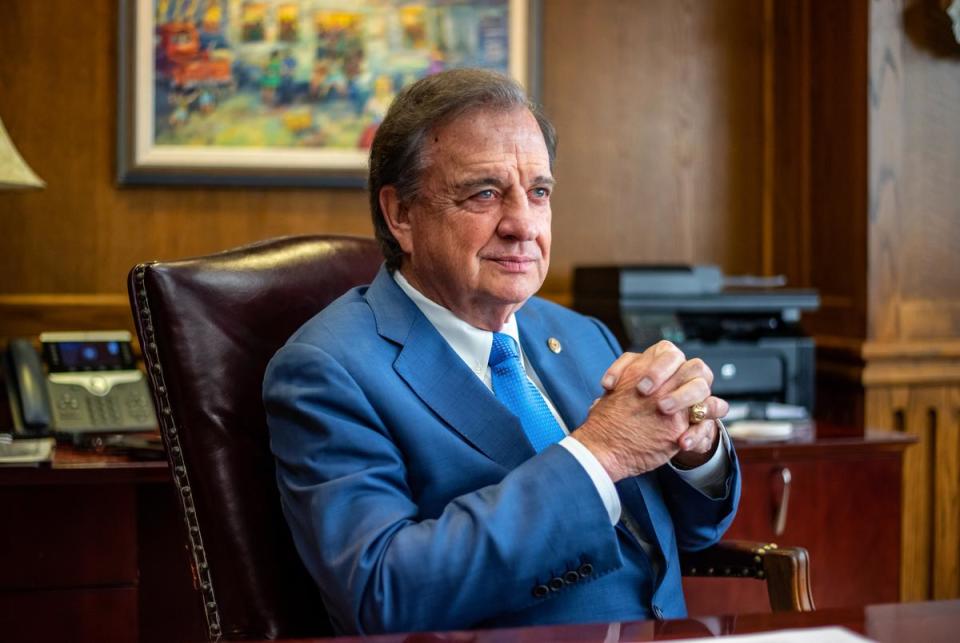
Looking forward
If Sharp has his way, he’ll have at least five more years to cement his legacy in the A&M System. In 2021, the board extended Sharp’s contract through 2028. By then he will be 77 years old. It’s hard to think about who might fill his shoes; it’s not a conversation Sharp really wanted to entertain.
That’s because he still has goals left to achieve. He wants to improve Texas A&M’s medical school, and grow the RELLIS research campus to the status of a national laboratory. And he's proven he can still adeptly maneuver the halls of the Texas Capitol when necessary.
But distrust in Texas A&M leadership persists. The Faculty Senate is still conducting its own investigations into what happened with McElroy’s hiring and the suspension of Alonzo, the professor who allegedly criticized Patrick during a talk on the opioid epidemic. Faculty leaders have been critical of Sharp at times during the controversies, but have also said they appreciate his instinct to engage with all parties.
“Given what he's been facing, and how difficult the various contrary positions are right now, he's been doing a really good job trying to navigate all sides of the aisle,” Tracy Hammond, president of the Texas A&M Faculty Senate, said.
A few weeks after Banks — who, months earlier, Sharp was calling the best president in A&M history — was forced out, A&M released a scathing report on what went wrong with her hiring, as well as a separate investigation into the disciplinary action taken against the opioids expert who was accused of criticizing the lieutenant government.
The report included a letter from Sharp to the Aggie community calling for unity.
“It is time to come together, put our house back in order, and vow to never let this happen again,” he wrote. “We all must rededicate ourselves to the Aggie values that define us and bind us.”
Sharp apologized for the treatment of McElroy, but defended his handling of the case involving Alonzo. The lieutenant governor, after all, is someone you have to keep happy.
“It has been suggested to me in the media that I let calls from state officials go to voicemail,” he wrote. “I assume that silly suggestion was meant as a clever turn of phrase, but I always found when you stop taking people’s calls, then they cease answering yours.”
With five years left on his contract, Sharp still has a lot of calls to make.
Disclosure: Texas A&M University, Texas Tech University, theTexas A&M University System, the University of Texas at Austin and the University of Texas System have been financial supporters of The Texas Tribune, a nonprofit, nonpartisan news organization that is funded in part by donations from members, foundations and corporate sponsors. Financial supporters play no role in the Tribune's journalism. Find a complete list of them here.
Correction, Oct. 3, 2023 at 12:18 p.m. : A previous version of this story incorrectly stated John Sharp's graduation year. It's 1972. Due to an editing error, it also gave a misleading description of Matthew Gaines' impact on A&M. As a state senator, he was integral to the founding of the university.

